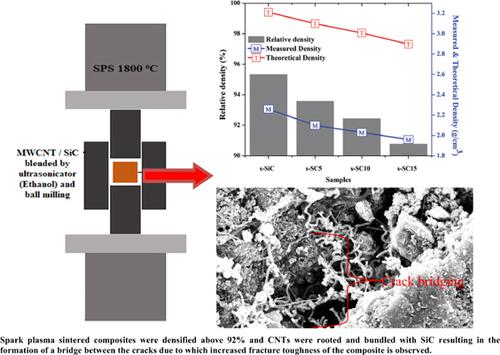Current Analytical Chemistry ( IF 1.7 ) Pub Date : 2021-06-30 , DOI: 10.2174/1573411016666200102120121 T. Arunkumar 1 , R. Karthikeyan 2 , R. Ram Subramani 2 , M. Anish 2 , J. Theerthagiri 3 , Rajender Boddula 4 , J. Madhavan 5

|
Background: Silicon Carbide (SiC) ceramics are promising engineering material due to its phenomenal properties, such as strong corrosion resistance, high-temperature hardness, wear resistance, high thermal conductivity and high stability in an aggressive environment. The key problem of SiC is low fracture toughness due to its brittle nature and to circumvent this, herein high ductile material like MWCNT was used as reinforcement by different proportions.
Methods: Nanocrystalline powdered Silicon Carbide (SiC) of particle size of 40 nm and x % weight ratio of SiC (x = 95%, 90% and 85%) + y % weight ratio of multiwalled carbon nanotubes (MWCNTs) of particle size of 20 nm (y= 5%, 10% and 15%) composites were ball milled and fabricated using spark plasma sintering process with temperature rate of 100°C/min and external pressure of 50 MPa. The sintered samples were tested according to ASTM standards to verify the mechanical properties of the samples. Furthermore, lattice strain and crystalline size was determined by XRD and the crack bridging mechanism was studied by FESEM.
Results: It was observed that the uniform distributions of MWCNTs were achieved through ultrasonication and ball milling processes, which play a predominant role in increasing fracture toughness. The fracture toughness of the composite improves drastically from 3.71 MPa m1/2 (100% SiC) to 10.21 MPa m1/2 (85% SiC-15% MWCNT). The theoretical and relative densities of the materials were gradually reduced due to the increase in MWCNTs which is due to the lower density of the reinforcement material and an increase in porosity of the samples.
Conclusion: The MWCNTs act as a bridging aid in sintered samples, FESEM image signifies some pull-outs and crack branching mechanisms of MWCNTs which is the reason for an increase in the fracture toughness of SiC.
中文翻译:

多壁碳纳米管对提高火花等离子体烧结碳化硅纳米复合材料断裂韧性的影响
背景:碳化硅(SiC)陶瓷由于其优异的性能,如强耐腐蚀性、高温硬度、耐磨性、高导热性和在侵蚀性环境中的高稳定性,是很有前途的工程材料。碳化硅的关键问题是由于其脆性而导致的断裂韧性低,为了解决这个问题,本文采用不同比例的高延展性材料如 MWCNT 作为增强材料。
方法:粒径为 40 nm 的纳米晶粉末碳化硅 (SiC) 和 SiC 的 x % 重量比(x = 95%、90% 和 85%)+ y % 重量比的多壁碳纳米管 (MWCNT) 的粒径为20 nm (y = 5%, 10% 和 15%) 复合材料球磨并使用放电等离子体烧结工艺制造,温度速率为 100°C/min,外部压力为 50 MPa。根据ASTM标准测试烧结样品以验证样品的机械性能。此外,晶格应变和晶体尺寸由 XRD 确定,裂纹桥接机制由 FESEM 研究。
结果:观察到 MWCNTs 的均匀分布是通过超声处理和球磨工艺实现的,这在提高断裂韧性方面起主要作用。复合材料的断裂韧性从 3.71 MPa m 1/2 (100% SiC)大幅提高到 10.21 MPa m 1/2 (85% SiC-15% MWCNT)。由于增强材料的较低密度和样品孔隙率的增加,MWCNT 的增加导致材料的理论和相对密度逐渐降低。
结论:多壁碳纳米管在烧结样品中起到桥接助剂的作用,FESEM 图像表明多壁碳纳米管的某些拉拔和裂纹分支机制是增加 SiC 断裂韧性的原因。










































 京公网安备 11010802027423号
京公网安备 11010802027423号